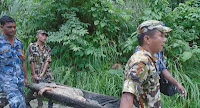Ninety-one people have been confirmed dead in flooding in Bihar State this Monsoon Season. Twenty eight of these deaths have been recorded in Purnea District, with 21 death in Kararia District, fifteen in Katihar, eight in Supual, five in Kishanganj, four each in Madhepura and Gopalganj, three in Darbhanga, and one each in Saharsa Saran and Muzaffarpur districts. In addition around 200 000 hectares of crops are reported to have been inundated and about 386 500 people are living in temporary evacuation camps.
A flooded village in Katihar District, Bihar. IANS.
Bihar is India's most flood-prone state, with major flooding incidents happening almost every Monsoon Season. Flooding in the state is driven by heavy rainfall in the mountains of eastern Nepal, which feeds the Narayani, Bagmati, and Koshi rivers, which flow into Bihar, where flooding occurs not on the steep, fast-flowing upper parts of the rivers, but the floodplains below where the rivers flatten out and cross the plains of northern India. This flooding contributes greatly to the fertility of the state's farmland, but a rising population has lead to more and more people living on the floodplains, with consequent problems during the flooding season. This has been made worse by a dam on the Koshi River in Nepal, which holds water for a hydroelectric plant and irrigation projects, but which sometimes needs to release large amounts of water to prevent high waters damaging the structure of the dam.
The Koshi River Dam in Nepal. Krish Dulal/Wikipedia.
Monsoons
are tropical sea breezes triggered by heating of the land during the
warmer part of the year (summer). Both the land and sea are warmed by
the Sun, but the land has a lower ability to absorb heat, radiating it
back so that the air above landmasses becomes significantly warmer than
that over the sea, causing the air above the land to rise and drawing in
water from over the sea; since this has also been warmed it carries a
high evaporated water content, and brings with it heavy rainfall. In the
tropical dry season the situation is reversed, as the air over the land
cools more rapidly with the seasons, leading to warmer air over the
sea, and thus breezes moving from the shore to the sea (where air is
rising more rapidly) and a drying of the climate. This situation is
particularly intense in South Asia, due to the presence of the
Himalayas. High mountain ranges tend to force winds hitting them
upwards, which amplifies the South Asian Summer Monsoon, with higher
winds leading to more upward air movement, thus drawing in further air
from the sea.
Diagrammatic representation of wind and rainfall patterns in a tropical monsoon climate. Geosciences/University of Arizona.
See also...
 Landslide kills one in Darjeeling District, West Bengal State, India. One person has died and another five have been treated for injuries
following a landslide at Bhotey Bhir in Darjeeling District, West Bengal
State, India...
Landslide kills one in Darjeeling District, West Bengal State, India. One person has died and another five have been treated for injuries
following a landslide at Bhotey Bhir in Darjeeling District, West Bengal
State, India... Multiple deaths after landslide pushes bus into ravine in Rasuwa District, Nepal. Thirty-four people are known to have died, twenty five people are being
treated in hospitals and many more people are missing after a landslide
swept a bus into ravine in Rasuwa District, Nepal, on...
Multiple deaths after landslide pushes bus into ravine in Rasuwa District, Nepal. Thirty-four people are known to have died, twenty five people are being
treated in hospitals and many more people are missing after a landslide
swept a bus into ravine in Rasuwa District, Nepal, on... Landslide hits bus in Palpa District, Nepal, killing at least three. Three people have been confirmed dead after a landslide hit a bus
traveling from Palpa to Butwal on the Siddhartha Highway...
Landslide hits bus in Palpa District, Nepal, killing at least three. Three people have been confirmed dead after a landslide hit a bus
traveling from Palpa to Butwal on the Siddhartha Highway...
Follow Sciency Thoughts on Facebook.



